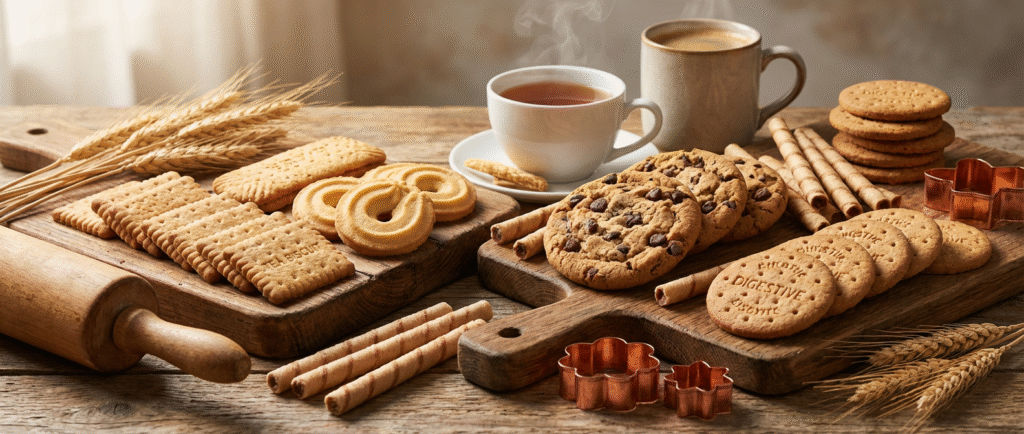🧁 Biscuits and Cookies — From Breakfast Classics to Global Bakery Business

Types of biscuits and cookies in the bakery
1. Introduction: The Sweet (and Savory) Start of Every Day
Few bakery items have achieved such timeless popularity as biscuits and cookies. They are among the oldest baked products known to humankind — simple in ingredients, yet rich in comfort and tradition. Whether paired with a hot cup of tea, served with coffee, or packed as a snack on the go, biscuits and cookies hold a special place in daily life around the world.
While both belong to the same family, biscuits and cookies differ slightly in texture and taste. A biscuit is typically crisp, light, and less sweet, while a cookie is richer, softer, and more indulgent. This subtle distinction is what gives bakeries a wide range of creative possibilities — from plain crackers to butter-loaded chocolate chip cookies.
Today, biscuits and cookies are not just comfort foods; they are a billion-dollar global industry, a daily breakfast essential, and a symbol of cultural diversity in taste and texture.
2. A Bite of History
The history of biscuits can be traced back to ancient Rome. The word “biscuit” comes from the Latin “bis coctus”, meaning “twice baked.” In those days, soldiers and travelers needed dry, durable food that could last for weeks — and thus, hard-baked bread became their staple.
As baking techniques evolved in Europe, biscuits took on sweeter and more refined forms. In medieval times, they were flavored with honey and spices, becoming a luxury treat for nobles. Across the Atlantic, American bakers developed their own version — softer, chewier, and loaded with butter and chocolate — the modern cookie.
By the 19th and 20th centuries, industrial baking revolutionized biscuit production. Mechanized ovens, automated dough mixers, and airtight packaging transformed small bakery treats into global consumer goods. Companies like McVitie’s, Britannia, Nabisco, and Parle built empires on these humble snacks.

3. Types of Biscuits and Cookies
The world of biscuits and cookies is incredibly diverse. Their variations depend on texture, ingredients, and the occasion they are made for.
A. By Texture
- Hard Biscuits – Light and crisp, these include Marie biscuits, crackers, and digestives. Perfect for tea-time and easy to store for long periods.
- Soft Cookies – Rich and chewy, such as chocolate chip, oatmeal, or butter cookies. These have higher moisture and fat content for a softer bite.
B. By Ingredients
- Shortbread – Made with high butter content for a melt-in-the-mouth texture.
- Whole-Grain and Multigrain Biscuits – Targeted toward health-conscious consumers.
- Sugar-Free or Diabetic-Friendly Biscuits – Sweetened with natural alternatives like stevia.
- Cream-Filled and Chocolate-Coated Biscuits – Popular among children and for gifting.
- Protein or Fiber-Enriched Cookies – A newer category catering to fitness and wellness markets.
C. By Function or Occasion
- Breakfast Biscuits: Energy-rich and often fortified with vitamins and fiber.
- Tea-Time Snacks: Lightly sweetened or savory biscuits paired with tea or coffee.
- Dessert Cookies: Premium cookies with chocolate chunks, nuts, or fruits.
- Children’s Treats: Fun shapes, colorful icing, and cream fillings to attract younger consumers.
4. Ingredients and Baking Techniques
At the heart of every biscuit and cookie lies a simple formula — flour, fat, sugar, and a leavening agent. Yet, it is the balance and technique that create the magic.
Flour provides structure; sugar adds sweetness and color through caramelization; fat (butter, margarine, or oil) provides tenderness and flavor. Baking powder or soda gives a light rise, while eggs add richness in cookies.
In biscuit production, the dough is mixed to just the right consistency — not overworked, to avoid toughness. It is then sheeted, cut, baked at 180–220°C, cooled, and packaged. Cookies often use a creaming method, where butter and sugar are beaten first to trap air, resulting in a lighter, softer texture.
Modern commercial bakeries use automated tunnel ovens and conveyor systems to ensure consistent quality. Emulsifiers and improvers are added to control spread, texture, and moisture retention.
5. Biscuits and Cookies in Breakfast Culture
In today’s fast-paced world, breakfast biscuits and cookies have become a symbol of convenience. Many people skip traditional breakfasts in favor of something portable yet filling — a biscuit bar or fiber-rich cookie with coffee.
Hotels, airlines, and cafés also rely heavily on biscuits and cookies as part of their breakfast service. Individually wrapped butter cookies, mini muffins, and digestives often complement continental breakfast spreads.
Leading brands like Belvita, Britannia NutriChoice, and Parle Platina have introduced fortified biscuits that promise sustained energy release throughout the morning. These are typically enriched with whole grains, iron, and B-vitamins.
From a nutrition standpoint, traditional biscuits are energy-dense but not always balanced. The modern market has responded with healthier versions — reduced sugar, high fiber, or gluten-free options — making them suitable for both health-conscious and busy consumers.
6. Commercial and Market Perspective
The global biscuit and cookie industry is one of the most dynamic segments in the food sector. According to recent industry reports, the global biscuit market is valued at over USD 150 billion and continues to grow steadily, driven by snacking habits and urban lifestyles.
A. Global Industry Overview
- Europe remains the largest consumer market, followed by Asia-Pacific and North America.
- India, in particular, has seen exponential growth, with giants like Britannia, Parle, and ITC dominating the market.
- In Western countries, cookies hold more market share, while in Asia, biscuits — both sweet and savory — are more common.
Top international players include Mondelez International (Oreo, Chips Ahoy!), Nestlé, Unibic, and Walkers. Regional brands continue to thrive through unique flavors and local ingredients.
B. Production and Supply Chain
Biscuit manufacturing is a well-structured process involving:
- Raw Material Procurement – Flour, sugar, fats, milk powder, and flavorings.
- Processing – Mixing, shaping, baking, cooling, and inspection.
- Packaging – To ensure freshness and shelf life.
- Distribution – Through wholesalers, retailers, supermarkets, and now e-commerce.
Large-scale producers invest heavily in quality control systems, food safety certifications (FSSAI, ISO 22000, HACCP), and research for flavor innovation.
7. Packaging and Shelf Life
Packaging plays a critical role in maintaining the crispness, aroma, and freshness of biscuits and cookies. Since these products are moisture-sensitive, packaging must act as a barrier against humidity, oxygen, and light.
Common Packaging Materials
- Laminated plastic films – Provide a moisture barrier and are commonly used for single packs.
- Metalized films – Offer higher protection and are suitable for export packaging.
- Paperboard boxes or tins – Used for premium cookies and gift assortments.
- Eco-friendly pouches – Increasingly popular due to sustainability trends.
Modern packaging also involves nitrogen flushing to prevent oxidation and extend shelf life. In addition, single-serve packs have gained popularity for portion control and convenience, especially in urban markets and vending machines.
Labeling regulations now require nutritional information, allergen warnings, and expiry dates — ensuring transparency and consumer trust.
8. Business and Commercial Use
Biscuits and cookies are one of the few bakery items that can be produced both on a small scale and industrially with great success.
A. Small Bakery Perspective
Local bakeries often focus on specialty cookies — fresh-baked butter cookies, handmade shortbread, or artisanal chocolate chip varieties. These products rely on quality, freshness, and customization rather than large volume.
Small entrepreneurs can enter the market with minimal investment using semi-automatic machines. Profit margins can be attractive, especially when targeting niche markets like “healthy snacks” or “organic cookies.”
B. Industrial Production
Large factories operate on automated lines capable of producing several tons per day. Consistency, long shelf life, and large distribution networks are their main strengths. Brands often invest heavily in marketing, packaging design, and product diversification to capture consumer attention.
C. Retail and Distribution
The product journey continues from factories to retail stores, supermarkets, cafés, online shops, and export markets. E-commerce has opened new doors for small bakers to sell directly to customers.
Exporters must meet international standards such as FDA (USA) or EU food regulations, while maintaining consistent flavor, packaging, and labeling.
9. Consumer Behavior and Market Trends
Consumer preferences in biscuits and cookies are constantly evolving. While traditional flavors like butter, chocolate, and vanilla remain strong, new innovations are reshaping the market.
Emerging Trends
- Health and Wellness – Demand for low-sugar, high-fiber, and protein biscuits is rising.
- Exotic Flavors – Matcha, caramel sea salt, red velvet, and coffee-infused cookies.
- Premiumization – Gourmet and handcrafted cookies with artisanal packaging.
- Festive and Seasonal Markets – Christmas cookies, Eid biscuits, Valentine’s gift boxes.
- Sustainability – Brands focusing on recyclable packaging and ethically sourced ingredients.
Millennials and Gen Z consumers prefer snacks that combine taste with health value. This has pushed major companies to reformulate products and introduce new variants that fit into “guilt-free indulgence” categories.
10. Conclusion: From Everyday Snack to Global Commodity
From their humble beginnings as twice-baked bread for travelers to their modern role as breakfast staples and premium desserts, biscuits and cookies have come a long way. They represent a perfect blend of tradition, innovation, and commercial success.
In every form — crisp or chewy, sweet or savory — these small bakery items continue to bring joy across generations and cultures. The biscuit industry stands as a shining example of how simplicity, when perfected, can become a global phenomenon.
Looking ahead, the future of biscuits and cookies will revolve around healthier recipes, sustainable packaging, and creative flavors that satisfy both nostalgia and modern taste trends. For bakers, investors, and everyday snack lovers alike, this timeless bakery category remains as irresistible as ever.
Expand Your Reading
Discover more content you might enjoy
